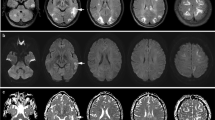Abstract
Purpose
To explore the clinical and imaging characteristics and summarize the causes of missed diagnosis of reversible posterior leukoencephalopathy syndrome (RPLS) in eclampsia.
Methods
We collected the data of a total of 45 patients with RPLS who were misdiagnosed initially (27 cases were confirmed and 18 cases were suspicious) out of 804 patients with severe eclampsia who had presented themselves to the Affiliated Hospital of Xuzhou Medical University from January 2014 to December 2016. We summarized the clinical and imaging characteristics of the patients and analyzed the possible causes of the misdiagnosis.
Results
Among the 804 patients with eclampsia, 45 were misdiagnosed the first time. Their clinical manifestations included headache (20 cases), epilepsy (13 cases), blurred vision (11 cases), disturbance of consciousness (2 cases), and drowsiness (3 cases). The parietal lobe was involved in 22 cases, the occipital lobe in 15 cases, the frontal lobe in 20 cases, basal ganglia in 9 cases, and the temporal lobe in 8 cases. Low-density lesions were observed on computed tomography (CT) scans. Head magnetic resonance (MR) scans showed hypo-intense lesions on T1-weighted image (T1WI), hyper-intense lesions on the T2-weighted image (T2WI) and fluid-attenuated inversion recovery (FLAIR), iso-intense or slightly hyper-intense lesion on diffusion-weighted imaging (DWI), and slightly hyper-intense or hypo-intense lesion on apparent diffusion coefficient (ADC).
Conclusion
The incidence of reversible posterior leukoencephalopathy syndrome is extremely high. The clinical features include headache, mental disturbance, seizures, blurred vision, and other neurological symptoms. The lesion area is mainly limited to the parietal and occipital lobes; however, the frontal lobe, basal ganglia, temporal lobe, corpus callosum, and cerebellum can also be involved. The prognosis is good with timely and appropriate treatments.

Similar content being viewed by others
References
Hinchey J, Chaves C, Appignani B, Breen J, Pao L, Wang A, Pessin MS, Lamy C, Mas JL, Caplan LR (1996) A reversible posterior leukoencephalopathy syndrome. N Engl J Med 334(8):494–500
Porcello Marrone LC, Gadonski G, de Oliveira Laguna G, Poli-de-Figueiredo CE, Pinheiro da Costa BE, Lopes MF (2014) Blood-brain barrier breakdown in reduced uterine perfusion pressure: a possible model of posterior reversible encephalopathy syndrome. J Stroke Cerebrovasc Dis 23(8):2075–2079
Fugate JE, Rabinstein AA (2015) Posterior reversible encephalopathy syndrome: clinical and radiological manifestations, pathophysiology, and outstanding questions. Lancet Neurol 14(9):914–925
Yiş U, Karaoğlu P, Kurul SH, Soylu A, Çakmakçi H, Kavukçu S (2016) Posterior reversible leukoencephalopathy syndrome with spinal cord involvement in a 9-year-old girl. Brain and Development 38(1):154–157
Rykken JB, McKinney AM (2014) Posterior reversible encephalopathy syndrome. Semin Ultrasound CT MR 35(2):118–135
Siebert E, Bohner G, Endres M, Liman TG (2014) Clinical and radiological spectrum of posterior reversible encephalopathy syndrome: does age make a difference?—a retrospective comparison between adult and pediatric patients. PLoS One 9(12):e115073
Singh RR, Ozyilmaz N, Waller S, U-King-Im JM, Lim M, Siddiqui A, Sinha MD (2014) A study on clinical and radiological features and outcome in patients with posterior reversible encephalopathy syndrome (PRES). Eur J Pediatr 173(9):1225–1231
Chen S, Hu J, Xu L, Brandon D, Yu J, Zhang J (2016) Posterior reversible encephalopathy syndrome after transplantation: a review. Mol Neurobiol 53(10):6897–6909
Gao B, Lv C (2014) Posterior reversible encephalopathy syndrome in 46 of 47 patients with eclampsia: beyond it. Am J Obstet Gynecol 211(1):83–84
Funding
This paper was supported by the National Natural Science Foundation of China (Grant No. 81271268).
Author information
Authors and Affiliations
Corresponding authors
Ethics declarations
Conflict of interest
The authors declare that they have no conflict of interest.
Additional information
Publisher’s note
Springer Nature remains neutral with regard to jurisdictional claims in published maps and institutional affiliations.
Rights and permissions
About this article
Cite this article
Shen, T., Chen, H., Jing, J. et al. A study on clinical characteristics and the causes of missed diagnosis of reversible posterior leukoencephalopathy syndrome in eclampsia. Neurol Sci 40, 1873–1876 (2019). https://doi.org/10.1007/s10072-019-03914-3
Received:
Accepted:
Published:
Issue Date:
DOI: https://doi.org/10.1007/s10072-019-03914-3




